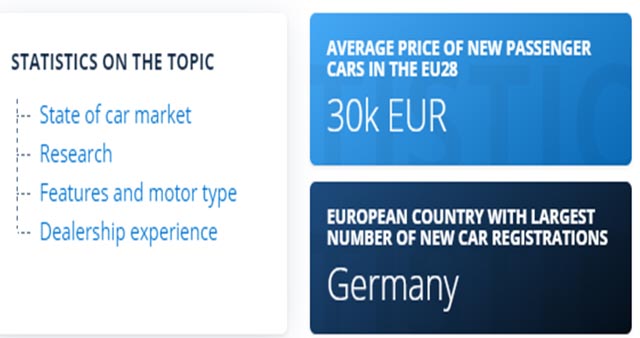In 2019, Norway had the highest prices for new passenger vehicles sold. Norwegians had to dig further into their pockets than any of their European counterparts in the previous four years, with prices nearly 17,000 euros higher than the EU-28 average. The high cost of automobiles in Norway is attributed in part to higher tax rates than in most other European countries. All new and used passenger vehicles brought into the nation are subject to a 25% VAT, while automobile registration taxes are calculated based on the vehicle's weight, CO2 and NOx emissions.
average price of a passenger automobile in the EU
In 2015 and 2019, the average price of a passenger automobile in the EU (including taxes), by country*
These incentives contribute to the cost of larger, heavier cars with petrol and diesel engines being higher in the United Kingdom than elsewhere in Europe. Electric automobiles were the only vehicles free from VAT and tolls. In comparison to most other nations, electric vehicles are highly popular in Norway, where customers can afford to pay more on high-tech versions.
The average car tax rate in the Nordic nations is higher.
Croatia is another European country having a 25% purchase tax rate.Denmark and Sweden had the highest rates, while Hungary's were two percent higher than Norway's. As this graph shows, higher tax rates on passenger automobiles result in higher total pricing. Sweden and Denmark were also included among the top seven most costly nations to buy a car. As a result, Northern European countries lagged behind not just their more populous neighbours, but even other smaller nations with lower tax rates in terms of new automobile registrations.
Passenger automobile prices are expected to remain steady.
In the next three years, passenger automobile prices are projected to remain largely constant, with only minor increases predicted. The only category whose prices changed was luxury automobiles.
Consumers in Germany were Europe's largest group of vehicle buyers. In 2017, there were 18.1 million new automobile registrations in Europe, with Germany accounting for more than 20% of all new registrations. Consumers in the EU28 paid an average of 28,855 euros for a passenger automobile. Denmark was the most costly nation in the EU28 for these purchases, but it was behind Norway and Switzerland. The VW Golf was the most popular vehicle in Europe in the second half of 2018, with 189,371 units sold.
 |
| The average price of a passenger automobile in the EU (including taxes), by country |
Belgians were the most likely of the customers in Belgium, France, Germany, Italy, and the United Kingdom to buy a car on the same day they went to the showroom, while the percentage of those who waited around a month was still larger at 35%. Italians, on the other hand, took the longest to contemplate purchases, with more than half of those polled taking roughly a month.
Statistics and Facts about Car Purchasing in Europe
Belgians were also the most interested in the option of buying a car online without visiting a dealership, according to the same study. This might be due to a lack of availability/stock at dealerships, which was cited by Belgian customers as the second most dissatisfying aspect of their dealership experience.
In terms of specific features, more than half of respondents in the aforementioned European nations were interested in automobiles that could detect issues and schedule service appointments on their own.
Germany was the exception, with only 44 percent expressing such an interest. The majority of German customers had a positive impression of auto dealers, with 70% stating that they were pleased with the excellent deal they were able to get when buying a car from a dealership.
Comments
Post a Comment